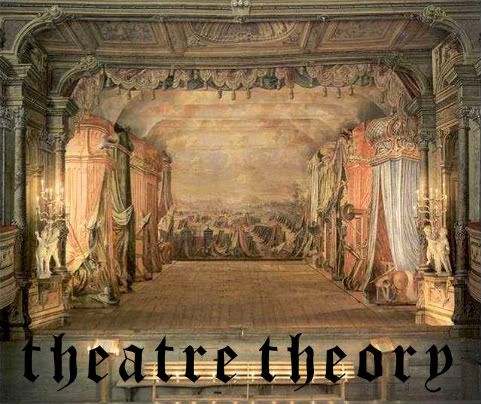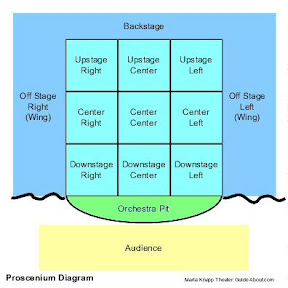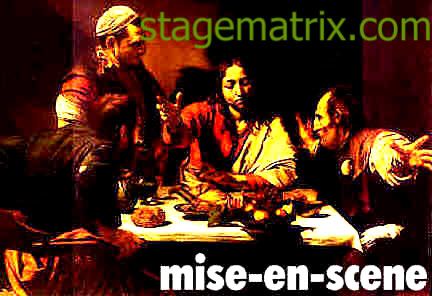Aristotle's 3 structural principles: (Plot/Action, Character/Hero, Idea/Thought) in 200x Files (dict).
see mise-en-scene and metrics pages !
also, vectors in old biomechanics for actors files
"Power Fight" (space): Carol takes John's space. Keep pushing him to the door (CR), as he did in act I.
Carol's light (color?) dominates in 3... The final physical fight (his attack) = ending. She won.
Blocking (stage)
From Wikipedia, the free encyclopedia
Blocking is a theatre term which refers to the precise movement and positioning of actors on a stage in order to facilitate the performance of a play, ballet, or opera.
The director usually determines blocking during rehearsal, telling actors where they should move for the proper dramatic effect and to ensure sight lines for the audience.
Each scene in a play is usually 'blocked' as a unit, after which the director will move onto the next scene. The positioning of actors on stage in one scene will usually affect the possibilities for subsequent positioning unless the stage is cleared between scenes. Once all the blocking is completed a play is said to be 'fully blocked' and then the process of 'polishing' or refinement begins. During the blocking rehearsal usually the assistant director or the stage manager (or both) take notes about where actors are positioned and their movement patterns on stage.
It is especially important for the stage manager to note the actors' positions, as a director is not usually present for each performance of a play and it becomes the stage manager's job to ensure that actors follow the assigned blocking from night to night.
By extension, the term is sometimes used in the context of cinema to speak of the arrangement of actors in the frame. In this context, there is also a need to consider the movement of the camera as part of the blocking process (see Cinematography).
Stage blocking is one of the most basic and technical elements of play direction, but should never be taken lightly by the director. Indeed there are a few other elements of a play that are more exciting and glamorous, but blocking provides the backbone and structure needed to make those other elements a reality. Basically, blocking is the choreography of actors' movements throughout the entire play. If a character needs to exit the scene, for example, the actor must be able to move naturally towards the exit. The director's goal is to come up with a plausible means of getting that actor across the stage and through the door, window, transporter beam or whatever. The same holds true for a character delivering a monologue- should they break away from the other actors or deliver the speech in the middle of a crowd? Other considerations when block may include entrances of a character, or places for actors to go when their character has no function in the scene. [ ... ]
see ACTOR' SCRIPT" and "director's text"
[ forms ]
[Oleanna] scenes: exposition? finale?
ACTING AREAS (how many?) :
sofa
desk
door
blackboard
slide projector (self as podium) -- not fully developed
book shelf --
Coat tree --
Two chairs -- dynamics?
Changes from 1 to 2 to 3 -- more visible! "Boxes story"? Is it acting area too?
"blocking camera" (spectator) -- film class
second character as spectator (POV)
in class:
1. What is Blocking(Staging)
2. The Four(?) Parts to Blocking a Scene
3. Director Questions for Blocking
4. A Blocking Demonstration
First direction -- SCRIPT
Second -- Set (designers)
Third -- actor (casting)
Forth -- prop (page): phone, chair ...
[ make copies of YOUR ground plan for each unit ]
"E-Motion" (lecture): positive - negative vectors
UP and DOWN, RIGHT and LEFT ( + and - )
Diagonal directions
[ ... ]
* film -- script breakdown in shots blocking (camera)
Director, stage directions are your TEXT (in bold).
* Use of film production techniques in stage directing (storyboarding) * Film Directing class
"Invisible Choreography" -- Dances Characters dance...
Blocking for Comedy
Staging conflict (mise-en-scene)
Shrew -- P-Kate
Hamlet (list of scenes)
Earnest -- suggested scenes.
...
scenes and scene study pages [acting I, II, III]
...
... mise-en-scene pages [ list ] part II or III ?



